微生态产品使用手册
佩科 VxPro 生态 2 系列快速入门指南说明书
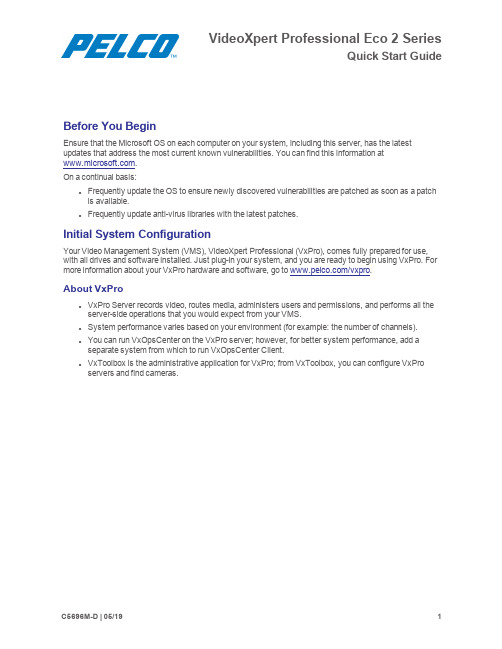
VideoXpert Professional Eco2SeriesQuick Start GuideBefore You BeginEnsure that the Microsoft OS on each computer on your system,including this server,has the latest updates that address the most current known vulnerabilities.You can find this information at.On a continual basis:l Frequently update the OS to ensure newly discovered vulnerabilities are patched as soon as a patch is available.l Frequently update anti-virus libraries with the latest patches.Initial System ConfigurationYour Video Management System(VMS),VideoXpert Professional(VxPro),comes fully prepared for use, with all drives and software installed.Just plug-in your system,and you are ready to begin using VxPro.For more information about your VxPro hardware and software,go to /vxpro.About VxProl VxPro Server records video,routes media,administers users and permissions,and performs all the server-side operations that you would expect from your VMS.l System performance varies based on your environment(for example:the number of channels).l You can run VxOpsCenter on the VxPro server;however,for better system performance,add a separate system from which to run VxOpsCenter Client.l VxToolbox is the administrative application for VxPro;from VxToolbox,you can configure VxPro servers and find cameras.Setting Up Your System1.Unpack the server.2.Connect the system and its peripherals.l Connect the monitor to an independent video controller(item10in Locating Connections on the Back Panel);onboard VGA is disabled.l Connect the VxPro system to the network using one of the Ethernet ports(item3in Locating Connections on the Back Panel).l You can also connect to the iDRAC port(item5in Locating Connections on the Back Panel)to configure and monitor the system remotely;however,the iDRAC port will not connect theVxPro system to the network.3.Connect the power supply(item7in Locating Connections on the Back Panel)to an electrical outlet.4.Power on the system by pressing the power button on the front panel or using iDRAC.Getting Started with VxProUpon starting your VxPro system,you will start a fully-functional60-day trial of the VxPro software.You must install a license before the60-day period is over to continue using VxPro.1.Start your VxPro hardware.2.Log on using the following default Windows user account credentials:l Username: Pelcol Password: Pel28991003.Pelco recommends that you change the default Windows password immediately,to secure accessto the system.This automatically opens the Initialize Pelco VideoXpert Professional window.4.Click Get Started.This starts the initialization process.Note:This also starts the60-day trial of the VxPro software.5.If the initialization process is interrupted,or you need to launch it again for any reason,do one of thefollowing:l Log out and log back in.l Reboot the system.6.When prompted by VxToolbox(which launches automatically),set the password for the admin useron your VxPro system,and then click Set Password.7.When prompted,enter the Company Name and the VideoXpert System Name,and then click Save.This is the information by which the Pelco licensing portal will recognize your VxPro server.Caution:After these values are set,they cannot be changed.8.Exit VxToolbox.9.Go to /vxpro to download and upgrade to the latest version of the VxPro software.unch VxToolbox from the desktop icon.11.Click the System tab,click the General Settings tab on the System page,and then enter a friendlyname in the VideoXpert System Name field.This is the name by which VxOpsCenter workstations and aggregation servers will recognize your VxPro server.12.Click Save Settings.13.Find and add cameras to the VxPro system:a.Click the Devices tab.b.Click the Advanced Discovery Options icon()to the right of the Quick Discovery icon().c.Click Quick Discovery and Add.All Devices and Data Sources that are discovered by VxToolbox are added to the VxProsystem to which you are connected.VxPro is now recording cameras and ready to be accessed by VxOpsCenter workstations.You can add users to the system,manually add cameras,configure events,or perform other administrative and operator tasks.For more information about VxPro hardware and software,and to access the current version of the VideoXpert Professional Operations Manual,go to /vxpro.CAUTION: The60-day trial of the VxPro software has begun.Before the60-day period is over,activate SUPs and install all channel licenses for your system.See the current version of theVideoXpert Professional Operations Manual for instructions.Standards OrganizationFirm;ISO 9001Quality System Pelco,Inc.625W.Alluvial,Fresno,California93711United States(800)289-9100Tel(800)289-9150Fax+1(559)292-1981International Tel+1(559)348-1120International FaxPelco,the Pelco logo,and other trademarks associated with Pelco products referred to in this publication are trademarks of Pelco,Inc. or its affiliates.ONVIF and the ONVIF logo are trademarks of ONVIF Inc.All other product names and services are the property of their respective companies.Product specifications and availability are subject to change without notice.。
Biolog GP2 微生物鉴定微孔板使用手册

Biolog GP2 微生物鉴定微孔板使用手册用途GP2微孔鉴定板提供了标准化的95种反应用于鉴定一大类革兰氏阳性好氧细菌。
Biolog的MicroLog1、MicroLog 2、MicroStation或OmniLog软件根据GP2微孔板的代谢模式对该种微生物进行鉴定。
描述Biolog微孔板检测微生物利用或氧化预先选择好的不同碳源的能力。
该检测产生了紫色孔的特征模式,进而构成了微生物利用不同碳源的代谢指纹。
所有必需的营养物质和生化试剂都预先加入并冻干在各个孔内,四唑紫作为氧化还原染料在颜色上指示微生物对碳源利用的情况。
整个鉴定过程非常简单。
需要鉴定的菌株在固体培养基上生长,然后在推荐的浓度下用特殊的接种液制成菌悬液。
菌悬液以每孔150µl接种到鉴定微孔板上,接种的时候所有的孔都是无色的。
在培养期间,在一些孔(阳性孔)里微生物利用相应的碳源进行代谢,而显色物质会被还原成紫色。
阴性孔和对照孔(A-1:不含碳源)保持无色。
微孔板培养4-6个小时和/或16-24个小时,让微生物充分的利用碳源,以形成稳定的碳源代谢指纹。
软件自动将微孔板的数据和数据库进行对比,得出和数据库中最相似的菌株名称。
注意事项为了得到准确和可重复性的结果,务必注意下列事项。
1.所要进行鉴定的微生物必须是纯种,此系统不是为在混合菌群中鉴定单一菌种而设计的。
2.在鉴定之前,选择合适的培养基和进行适量的传代培养是非常重要的。
在接种之前,许多菌种会因为培养条件的不同而产生不同的代谢模式。
3.在操作过程中必须使用无菌器材和进行无菌操作,杂菌的污染会干扰结果。
4.大多数消耗品为一次使用,重复使用的如试管,移液器枪头必须把去污剂清洗干净,残留的清洁剂会影响鉴定结果。
5.在将菌悬液接种到鉴定板之前,应把鉴定板拿出冰箱,让鉴定板恢复到常温。
因为有些菌种(如Neisseria)对温度的快速变化很敏感。
6.仔细校正浊度计,接种菌悬液的浊度应在规定的范围内。
帕尔-泰克 Micro-24微型生物反应器 使用说明书 (USD 2819(1))
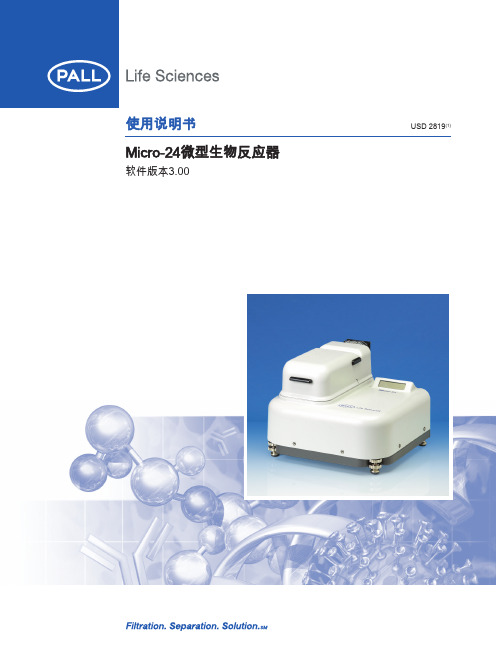
使用说明书USD 2819(1) Micro-24微型生物反应器软件版本3.002/biopharm3目录1. 安全须知 (5)2. 导言 (6)2.1 Micro-24微型生物反应器系统组件 (6)2.2 Micro-24系统硬件概述 (7)2.2.1 Micro-24微型生物反应器引擎 (7)2.2.2 Micro-24微型生物反应器培养小室 (7)2.2.3 Micro-24微型生物反应器显示屏 (7)2.2.4 Micro-24微型生物反应器外盖 (8)2.2.5 Micro-24微型生物反应器后面板 (8)2.2.6 Micro-24微型生物反应器调平支脚 (8)2.2.7 加压氨罐 (9)2.2.8 Micro-24微型生物反应器笔记本电脑控制器 (9)3. 硬件安装要求 (10)3.1 气管 (10)3.2 电源要求 (10)4. 软件 (10)4.1 控制面板 (11)4.2 反应器信息面板 (12)4.3 培养盒吸附按钮循环 (14)4.4 反应器控制面板下拉菜单 (15)4.4.1 文件 (15)4.4.2 配置 (15)4.4.3 维修 (18)4.4.4 帮助 (19)5. Micro-24微型生物反应器培养盒 (20)5.1 消泡考虑事项 (21)5.2 盒子概述及处理指南 (21)5.3 盒子密封盖 (22)6. 设备运行 (23)6.1 硬件连接 (23)6.2设置试验配置 (23)6.2.1 装载Micro-24培养盒 (24)6.2.2 将Micro-24盒吸附在引擎/Micro-24仪器上。
(24)6.2.3 开始运行 (25)6.2.4 暂停运行 (25)6.2.5 停止运行 (26)6.2.6 查看数据 (26)6.2.7 清洁与维护 (26)7. 预试验 (27)8. pH校准方法 (29)9. 设备批号 (30)10. 规格 (31)设备内部含有非维修部件任何输气管道的最高压力都是8.2巴(120 psi)电压– 通电前检查设备版本及电源要求。
Merck Millipore RCS High Flow Touch 微生物安全设备说明书
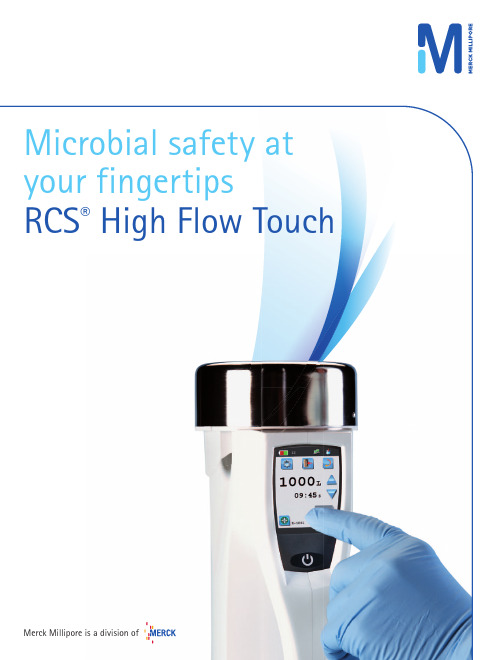
Merck Millipore is a division ofMicrobial safety at High Flow Touch2Cleanrooms and isolators in the pharmaceutical, medical and food industries are subjected to thorough microbial air monitoring routines to ensure high product quality, to maintain a safe work environment and to meetregulatory requirements such as ISO 14698-1 (Bio-contamination Control).The new RCS® High Flow Touch has been designed to meet these requirements and, furthermore, to provide maximum ease of handling. Employing the renowned RCS® High Flow technology,the instrument ensures reliable and reproducible results along with comprehensive validation documentation.New instrument features such as a high resolution color touchscreen, an intuitive software, a new battery concept with advanced control options and a modern, ergonomic design allow for maximum reliability in monitoring ambient air and compressed gas.Proven – renowned RCS ® High Flow technologyFast• S hort sampling times with a flow rate of 100 L/min • C onvenientprogramming with an easy touch • F rom preparation to start of measurement within a minuteReliable• P roven technology using standardized agar media• I nnovative battery concept with advanced control options • C ompatible with common sterilization and disinfection methodsRCS ® High Flow Touch – standardized air monitoring with an easy touch3Illustration of the Reuter Centrifugal Impaction PrincipleFlexible•P ortable, battery-driven and light weight•H orizontal and verticalinstallation, measure-ment at heights of upto 3 meters•U ser-defined samplingoptions like individualvolumes, time delay,interval sampling4New color touchscreen makes operation easy • M odern design for fast and easy handling • Commonly used symbols and functions • Quick change of menus, easy programming Intuitive user interface for user-friendly navigation • K ey information and setting changes on a single screen• S tandardized settings and flexible sampling options • Acoustic signaling• Management of up to ten rotors • Language optionsInnovative software solutions easily integrated • R CS® Management Software: Safety, control and flexibility• C alibSo Software: Automated calibration with HYCON® AnemometerConvenient – flexible operation with an easy touchThe RCS® High Flow Touch Microbial Air Sampler is equipped with a high-resolution color touch-screen and intuitive software for maximum ease-of-use. Self-explaining icons quickly guide through the menus.5Instrument status now easily monitoredThe RCS® High Flow Touch Software offers two control options for monitoring the battery status.• M ain window with status barThe status bar in the main window contains a battery status icon visualizing the remaining capacity of the battery. Dependent on the selected sampling volume, it also displays the remaining number of measurements.• S ystem information window displaying battery capacitiesThe total and actual capacities of the integrated battery are shownon the system’s information screen.Remaining cycles at the set volumeBattery capacityMain window with status barTotal battery capacity Remaining battery capacitySystem information window displaying battery capacitiesTo operate battery-driven instruments reliably easy recharging mechanisms and visual control options are required. The innovative battery concept of the RCS® High Flow Touch Microbial Air Sampler combines flexible charging options and reliable battery status reporting.• I ntegrated high capacity, long-life lithium-ion battery • C apacity to perform more than 30 x 1000 L measurements with one full charging cycle• C ontinuous capacity measurement of the battery• E asy cable-based recharging, or use of an optional docking station with LED control at any timeInnovative – operating reliability with innovative battery conceptLED-controlled docking station for easier chargingof the integrated battery6Robust – minimal service and maintenanceTechnical specificationsSampling principle Centrifugal impaction (Reuter Centrifugal Sampler, RCS)Operation Portable device, integrated color touchscreenElectrical supply Rechargeable Lithium-ion battery, power supply, (optional) docking station Air flow rate 100 L/min (1000 L in 10 min)Sample volumes 7 pre-set, 3 user-defined (1-2000 L)Rotor speed 8200 rpmDimension 300 x 130 x 110 mm (H x W x D)Weight 1500 gConnection Serial RS232, USB adapter, standard tripod threadMaterialH ousing: Lexan polycarbonate; head: aluminium/stainless steel (autoclave-able)Validation According to ISO 14698 with agar mediaCalibrationAutomated calibration (CalibSo Software, HYCON® Anemometer), calibration reminder User-defined settingsD ate/time, language, time delay, interval sampling, QA Management RCS® High Flow Touch Microbial Air Sampler withHYCON® AnemometerThe RCS® High Flow Touch Microbial Air Sampler is a robust instrument that requires minimal service and maintenance. To ensure its continued and reliable operability the rotor should be calibrated every year.• R eliable calibration and repair services carried out by Merck and by authorized service partners • I nstrument qualification plans and comprehensive validation documentation support provided upon installation• C alibration training on how to use the HYCON® Anemometer and the CalibSo Software conducted by our instrument specialistsRCS® High Flow Touch Microbial Air SamplerIncluding power supply, serial RS232 cable, USB adapter, RCS® Management Software, rotor, protection cap,carrying case, calibration certificate, quick start guide and user manual1.44194.0001Docking StationFor recharging the integrated Lithium-ion battery1.44256.0001RCS® Compressed Gas Adapter TouchAutoclave-able adapter for microbial monitoring of compressed gasses; designed for a pressure of 1 bar1.44257.0001Nozzle Set for RCS® Compressed Gas AdapterSet of five nozzles to extend the air inlet pressure from 1 bar to 0.1-7.0 bar1.44235.0001Sterile Sleeves10 pieces; for covering non-autoclave-able housing parts1.44199.0010TripodFor use at heights up to three meters1.44209.0001Table-top TripodFor horizontal operation1.44210.0001 RCS® High Flow Touch Validation HandbookGerman versionEnglish versionComprehensive compendium of validation data for RCS® Microbial Air Samplers (RCS® High Flow, RCS® Isolator, RCS® Plus) and Agar Strips; contains RCS® Qualification Handbook for RCS® High Flow Touch 1.44176.0001 1.44189.0001RCS® High Flow Touch Qualification HandbookGerman versionEnglish versionPlan for instrument qualification of the RCS® High Flow Touch in controlled areas, contains IQ / OQ / PQ 1.44178.0001 1.44192.0001CalibSoCalibration Software for automated, computer-aided calibration and data storage1.44206.0001HYCON® AnemometerPortable device for measuring the air flow rate during calibrationof RCS® Microbial Air Samplers1.44205.0001RotorSpare part, autoclave-ableEach combination of sampler and rotor must be calibrated separately1.44196.0001Protection CapSpare part (stainless steel), autoclave-able For protection of the rotor during air sampling 1.44225.0001Ordering information7Validated – complete system with standardized agar mediaUnique features of HYCON® agar strips for RCS® instruments• Total count and specialized agar media• A dditionally available: Gamma-irradiated products in double packaging for higher cleanroom classes • I ndividually packaged agar strips to ensure sterility • R igorous quality control during production, including visual inspection of each agar strip• P erformance, packaging and storage extensively validated• S torage at room temperature, ablity to resist repeated gassing cycles• I ncubation and evaluation within re-sealed packagingThe RCS® High Flow Touch Microbial Air Sampler is used with standardized agar media. These aremanufactured under strictly controlled aseptic conditions. Thus, the RCS® High Flow Touch Microbial AirSampler provides a complete system, which has been extensively validated according to ISO 14698-1.Open HYCON® agar strip wrapper1Insert HYCON® agar strip into rotor2Place rotor on instrument3Close the protection cap – system ready to start4SDXSabouraud Dextrose Agar with modified Pharmacopoeia formulation;for determination of yeasts and molds, store at 2-25 °C50 strips 1.44243.0050SDX-γSabouraud Dextrose Agar with modified Pharmacopeia formulation;for determination of yeasts and molds in aseptic environments, store at 2-25 °C40 strips 1.44244.0040DG-18Dichloran Glycerine Agar; for determination of yeasts and molds, store at 2-25 °C25 strips 1.44245.0025YMRose Bengal Agar with streptomycin; for determination of yeasts and molds,store at 2-25 °C50 strips 1.44242.0050CMacConkey Agar; for determination of coliform bacteria, store at 2-15 °C25 strips 1.44099.0025SMannitol Salt Agar; for determination of staphylococci, store at 2-15 °C25 strips 1.44102.0025Blank Strip KitEmpty strips for manual production of culture media for special applications50 strips 1.44107.0050Cover SlidesCover slides for agar strips to prevent desiccation during incubation100 slides 1.44111.0100Incubation Rack for Agar Strips Stainless steel, for HYCON® agar strips 1 1.44249.0001TCTryptic Soy Agar for determination of the total count, store at 2-25 °C50 strips 1.44253.0050TSMModified Tryptic Soy Agar with neutralizers against disinfectants and growth supple-ments; for identification of the total count of fastidious and sublethally damagedmicroorganisms, store at 2-25 °C50 strips 1.44240.0050TC-γGamma-irradiated Tryptic Soy Agar, double-wrapped; for determination of total count inaseptic environments, store at 2-25 °C40 strips 1.44226.0040TCI-γGamma-irradiated Tryptic Soy Agar with neutralizers, double-wrapped; for determinationof total count in aseptic environments and in peroxide-containing air, store at 2-25 °C40 strips 1.44228.0040PEN-γGamma-irradiated Tryptic Soy Agar with Penase; for determination of total count inpenicillin-containing air in aseptic environments, store at 2-25 °C40 strips 1.44109.0040LAC-γGamma-irradiated Tryptic Soy Agar with broadspectrum cephalosporinase;for determination of total count in aseptic environments containing antibiotics,store at 2-25 °C40 strips 1.44108.00409We provide information and advice to our customers on application technologies and regulatory matters to the best of our knowledge and ability, but without obligation or liability. Existing laws and regulations are to be observed in all cases by our customers. This also applies in respect to any rights of third parties. Our information and advice do not relieve our customers of their own responsibility for checking the suitability of our products for the e nvisaged purpose. The M mark is a trademark of Merck KGaA, Darmstadt, Germany. HYCON® and RCS® are registered trademarks of Merck KGaA, Darmstadt, Germany.For more information:/biomonitoring© 2012 Merck KGaA, Darmstadt, Germany. All rights reserved.W 289103 P B 4231E N 00 04/12。
EM菌使用手册
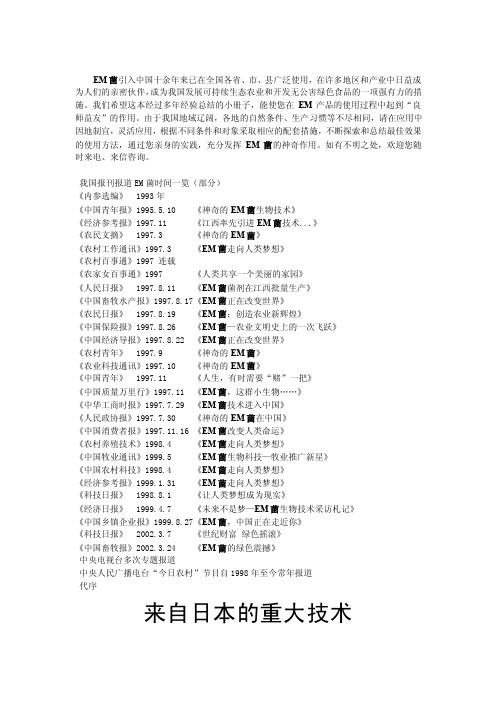
EM菌引入中国十余年来已在全国各省、市、县广泛使用,在许多地区和产业中日益成为人们的亲密伙伴,成为我国发展可持续生态农业和开发无公害绿色食品的一项强有力的措施。
我们希望这本经过多年经验总结的小册子,能使您在EM产品的使用过程中起到“良师益友”的作用。
由于我国地域辽阔,各地的自然条件、生产习惯等不尽相同,请在应用中因地制宜,灵活应用,根据不同条件和对象采取相应的配套措施,不断探索和总结最佳效果的使用方法,通过您亲身的实践,充分发挥EM菌的神奇作用。
如有不明之处,欢迎您随时来电、来信咨询。
我国报刊报道EM菌时间一览(部分)《内参选编》 1993年《中国青年报》1995.5.10 《神奇的EM菌生物技术》《经济参考报》1997.11 《江西率先引进EM菌技术...》《农民文摘》 1997.3 《神奇的EM菌》《农村工作通讯》1997.3 《EM菌走向人类梦想》《农村百事通》1997 连载《农家女百事通》1997 《人类共享一个美丽的家园》《人民日报》 1997.8.11 《EM菌菌剂在江西批量生产》《中国畜牧水产报》1997.8.17《EM菌正在改变世界》《农民日报》 1997.8.19 《EM菌:创造农业新辉煌》《中国保险报》1997.8.26 《EM菌—农业文明史上的一次飞跃》《中国经济导报》1997.8.22 《EM菌正在改变世界》《农村青年》 1997.9 《神奇的EM菌》《农业科技通讯》1997.10 《神奇的EM菌》《中国青年》 1997.11 《人生,有时需要“赌”一把》《中国质量万里行》1997.11 《EM菌,这群小生物……》《中华工商时报》1997.7.29 《EM菌技术进入中国》《人民政协报》1997.7.30 《神奇的EM菌在中国》《中国消费者报》1997.11.16 《EM菌改变人类命运》《农村养殖技术》1998.4 《EM菌走向人类梦想》《中国牧业通讯》1999.5 《EM菌生物科技—牧业推广新星》《中国农村科技》1998.4 《EM菌走向人类梦想》《经济参考报》1999.1.31 《EM菌走向人类梦想》《科技日报》 1998.8.1 《让人类梦想成为现实》《经济日报》 1999.4.7 《未来不是梦—EM菌生物技术采访札记》《中国乡镇企业报》1999.8.27《EM菌,中国正在走近你》《科技日报》 2002.3.7 《世纪财富绿色摇滚》《中国畜牧报》2002.3.24 《EM菌的绿色震撼》中央电视台多次专题报道中央人民广播电台“今日农村”节目自1998年至今常年报道代序来自日本的重大技术中国农业大学教授中国工程院院士◆学习日本先进农业技术并在我国大地上发扬光大、创造性地应用,是中日友好大厦的重要组成部分。
微生态应用手册110623

产品应用手册一、微生态制剂基础理论知识1.1名词解释微生态制剂:微生态制剂是指在微生态学理论指导下,调整微生态平衡失调,保持微生态平衡,提高宿主健康水平的正常菌群及其代谢产物和选择性促进宿主正常菌群生长的物质制剂总称。
生态平衡:宏生物生态平衡是指在一定时间内生态系统中的生物和环境之间、生物各个种群之间,通过能量流动、物质循环和信息传递,使它们相互之间达到高度适应、协调和统一的状态。
微生态平衡是指正常微生物群与其宿主生态环境在长期进化过程中形成生理性组合的动态平衡。
常住菌:又名内源菌。
即经常能从动物体内分离到的细菌,并且数量较多。
各种细菌依据其特性及其与宿主形成的适应性,定居于肠道的不同部位,形成其各自的菌落,每种细菌的数量和所占的比例在,不同细菌所定居的部位在每一种动物是相对恒定的。
外籍菌:又名外源菌、过路菌。
在动物肠道不定植或仅短暂停留在宿主上皮或肠道粘膜细胞的表面。
乳酸菌:是能利用葡萄糖(或可利用的碳水化合物)发酵产生乳酸的一类细菌。
芽孢杆菌:细菌的一类,能形成芽孢(内生孢子)的杆菌或球菌。
包括芽孢杆菌属(好氧或兼性好氧)、芽孢乳杆菌属(微好氧)、梭菌属(厌氧)、脱硫肠状菌属(厌氧)和芽孢八叠球菌属(厌氧)等。
芽孢:某些细菌在其生长发育后期,在细胞内形成的一个圆形或椭圆形、厚壁、含水量极低、抗逆性(抗热、化学药物、辐射等)极强的休眠体。
细菌生长曲线:生长包括4个周期:延迟期、对数生长期、稳定期、衰退期微胶囊技术:是物质包裹在聚合物薄膜中的技术,是一种储存固体、液体、气体的微型包装技术。
具体来说是指将某一目的物(芯或内相)用各种天然的或合成的高分子化合物连续薄膜(壁或外相)完全包覆起来,而对目的物的原有化学性质丝毫无损,然后逐渐地通过某些外部刺激或缓释作用使目的物的功能再次在外部呈现出来,或者依靠囊壁的屏蔽作用起到保护芯材的作用。
喷雾干燥技术:喷雾干燥是将悬浮液和粘滞的液体喷成雾状,形成具有较大表面积的分散微粒同热空气发生强烈的热交换,迅速排除本身的水分,在几秒至几十秒内获得干燥,成品以粉末状态沉降于干燥室底部,连续或间断地从卸料器排出。
EM 原液使用手册
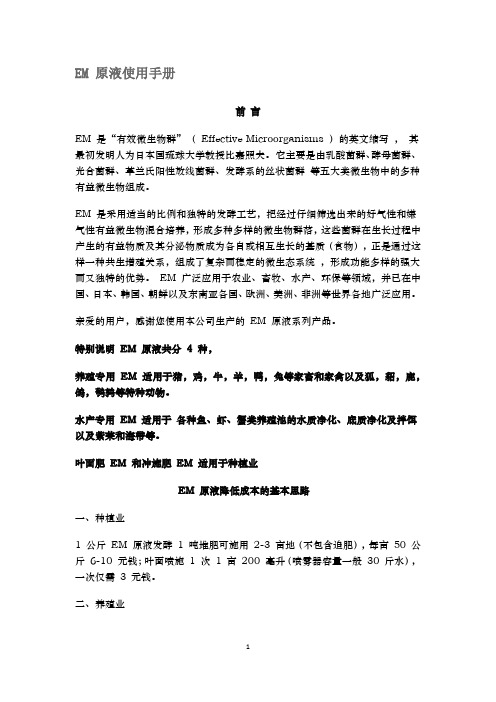
EM 原液使用手册前言EM 是“有效微生物群”(Effective Microorganisms )的英文缩写,其最初发明人为日本国琉球大学教授比嘉照夫。
它主要是由乳酸菌群、酵母菌群、光合菌群、革兰氏阳性放线菌群、发酵系的丝状菌群等五大类微生物中的多种有益微生物组成。
EM 是采用适当的比例和独特的发酵工艺,把经过仔细筛选出来的好气性和嫌气性有益微生物混合培养,形成多种多样的微生物群落,这些菌群在生长过程中产生的有益物质及其分泌物质成为各自或相互生长的基质(食物),正是通过这样一种共生增殖关系,组成了复杂而稳定的微生态系统,形成功能多样的强大而又独特的优势。
EM 广泛应用于农业、畜牧、水产、环保等领域,并已在中国、日本、韩国、朝鲜以及东南亚各国、欧洲、美洲、非洲等世界各地广泛应用。
亲爱的用户,感谢您使用本公司生产的EM 原液系列产品。
特别说明EM 原液共分4 种,养殖专用EM 适用于猪,鸡,牛,羊,鸭,兔等家畜和家禽以及狐,貂,鹿,鸽,鹌鹑等特种动物。
水产专用EM 适用于各种鱼、虾、蟹类养殖池的水质净化、底质净化及拌饵以及紫菜和海带等。
叶面肥EM 和冲施肥EM 适用于种植业EM 原液降低成本的基本思路一、种植业1 公斤EM 原液发酵1 吨堆肥可施用2-3 亩地(不包含追肥),每亩50 公斤6-10 元钱;叶面喷施1 次1 亩200 毫升(喷雾器容量一般30 斤水),一次仅需3 元钱。
二、养殖业以养猪为例。
1 公斤EM 原液发酵100 公斤饲料(1:100 ),然后和500--800 公斤(发酵饲料的比例为总饲料的10%-15% ),相混合,可养4 头猪左右,从小猪到出栏,加饮水(1:500 )和栏舍喷施(1:300 ),一头猪需投入15 元左右,可节约100 元左右(一羽肉鸡需投入0.3 元左右;育肥一头牛需投入30 元左右)。
以上不包含减少各种药费、提前上市、产品个大好吃无害、提高产量、改良土壤、改善环境等因素。
VWR数字微生物孵化器产品说明书

Microbiological IncubatorVWR Digital IncubatorINSTRUCTION MANUAL North American Catalogue Numbers:10055-006 Digital Incubator Personal Sized 115V10054-476 Digital Incubator Personal Sized 230VVersion: 1Issued: 11.03.2014Legal Address of ManufacturerNorth AmericaVWR International, LLCRadnor Corporate Center, Building One, Suite 200 100 Matsonford Road, Radnor, PA 19087USA610-386-1403Country of origin: SLOVENIATable of ContentsWarning (4)Safety information (4)Package Contents (4)Unpacking (5)Installation (5)Intended Use (5)Symbols and conventions (5)Product specifications (6)Overview (6)Description of front panel (6)Instructions for use (7)Getting started (7)Operation (7)Temperature re-adjustment (7)Troubleshooting (8)Cleaning and maintenance (8)Accessories (8)Technical Service (9)Warranty (9)Equipment disposal (9)Configuring and operating this equipment requires precise knowledge and observance of the instructions in this user manual. The equipment is designed only for its intended application.Important safety symbols used in this manual:Warning!This is a warning of risk situations and dangers. Failure to observe this warning could belife-threatening. These warnings must be heeded.This equipment is designed for 115V (50/60Hz) or 230V (50/60Hz).Make sure it is connected to the correct power supply.Disconnect the power cord before carrying out maintenance or cleaning work.Safety InformationThe responsibility for operating the equipment lies exclusively with the owner or user if said equipment is incorrectly serviced, maintained or altered by persons not employed by an authorized dealer, or if the equipment is used in a manner contrary to its specified purpose.The equipment must be maintained and operated in accordance with this user manual.Ensure that this user manual is accessible at all times and has been read and understood.To avoid electric shock do not spill any liquids on the equipment.Package ContentsDescription QuantityDigital Incubator 1Stainless steel shelf 1Power cord 1Carefully inspect the unit and accessories thoroughly upon receipt for any damage that may have occurred during shipping. Severe damage to the packaging container may indicate damage to the unit. If you suspect damage to the unit, immediately file a claim with the carrier in accordance with their instructions before contacting VWR. Also verify that all accessories are included and that the unit is in good working order before discarding the shipping packaging.InstallationYour satisfaction and safety require a complete understanding of this unit. Read the instructions thoroughly and be sure all operators are given adequate training before attempting to put the unit in use.NOTE: This equipment must be used only for its intended application; any alterations or modifications will void your warranty and may cause injury.Intended useVWR Digital Incubator is a compact general purpose convection incubator capable of uniformly heating samples up to a maximum of 70 ºC. The unit has a door window area, so the samples can be observed without opening the door, thus preventing heat loss.For research use only. Not intended for any animal or human therapeutic or diagnostic use.Symbols and conventionsThe following chart is an illustrated glossary of the symbols that are used in this manual.CAUTIONThis symbol indicates a potential risk and alerts you to proceed with caution.CAUTIONThis symbol indicates the presence of high voltage and warns the user to proceed with caution.CAUTIONThis symbol indicates risks associated with hot surfaces.Product SpecificationsSpecifications Digital Incubator 115V Digital Incubator 230V Electrical 115V, 50/60 Hz, 0.6 A 230V, 50/60 Hz, 0.3 A Controls PID control PID controlTemperature range Ambient +5 ºC to +70 ºC Ambient +5 ºC to +70 ºC Temperature accuracy at 37 ºC ± 0.5 ºC ± 0.5 ºCTemperature stability at 37 ºC ± 0.5 ºC ± 0.5 ºCEnvironment temperature +15 ºC to +40 ºC +15 ºC to +40 ºCInterior volume 10 l 10 lExterior dimensions w x d x h (mm) 285 x 280 x 335 285 x 280 x 335Interior dimensions w x d x h (mm) 230 x 220 x 200 230 x 220 x 200Weight 8.3 kg 8.3 kgOverviewDescription of front panelPOWER - power switch: For turning the incubator ON and OFF. It lights when incubator is switched ON. ▲ - UP key: For increasing the temperature.▼ - DOWN key: For decreasing the temperature.Display: For displaying the temperature (dot blinks when you set the temperature).Instructions for useGetting StartedCheck the data plate for voltage, cycle, wattage and ampere requirements. If matched to your power source, plug the power cord into a grounded outlet. Voltage should not vary more than 10% from the data plate rating.In selecting a location, consider all conditions which might affect performance, such as heat from radiators, autoclaves, etc. Avoid direct sun, fast-moving air currents, heating/cooling ducts and high traffic areas. Allow a minimum of 5 cm between the unit and walls or partitions which might obstruct free airflow.OperationDo not use this incubator in explosive or flammable environments. Do not heat or incubateflammable, explosive or highly reactive materials in this incubator as serious injury mayresult.Place the unit on a level surface and plug the unit into a properly grounded outlet of appropriate voltage.Install the shelf at the desired height, with the shelf edges up. If you intend to place the samples on the bottom of the chamber, install the shelf so that it sits with the edges down on the chamber bottom, thus creating an air gap between the chamber bottom and your samples.Place the samples in the chamber and close the door. Make sure the door is securely closed.Push the power switch to the ON position. The switch should illuminate. On display incubator automatically detect supply frequency F50 or F60. Incubator starts to heat.Set desired temperature with UP or DOWN key. You must hold UP or DOWN key for more than 2 sec. DOT on DISPLAY blinks. When DOT starts to blink (dot blinks for 5 sec) set temperature to desired value between room temperature +5 ºC to +70 ºC. When desired temperature is set, display will automatically show momentary temperature after 2 sec.You can always check the SET temperature by holding UP or DOWN key for more than 2 sec.Temperature re-adjustmentIncubator has software for temperature re-adjustment. You must first measure temperature in middle of chamber or in sample for minimum 2 hours. You must measure temperature with a certificated reference temperature measuring instrument with precision 0.1 ºC or more. After 2 hours or more read temperature on thermometer and compare it with temperature on LED display. Difference from thermometer and display is value, which you will enter in software.Example 1: Reference temperature is 37,9 ºC, temperature on display is 37 ºC. Difference is 37,9 – 37 = 0.9 Value is 0.9 (value which you enter in software).Example 2: Reference temperature is 36,2 ºC, temperature on display is 37 ºC. Difference is 36,2 – 37 = -0.8 Value is – 0.8 (value which you enter in software).Procedure for temperature re-adjustment:Press UP and DOWN key at the same time for more than 5 seconds – on display appears Cor (correction) and DOT blinks.With UP or DOWN key define value (when dot blinks). Pay attention on sign of value (plus or minus). After 5 sec when you will define temperature display will automatically show temporary temperature.TroubleshootingReview the information in the table below to troubleshoot operating problems.Problem ondisplayCause SolutionEr1 Temperature probe fault, electronic boardfault or incorrect setting of parameters.Contact your distributor.Er2 Momentary temperature in the incubator is at least 5 ºC higher than SET temperature,because the incubator has been working athigher SET temperature recently. Check if SET temperature is for 5 ºC, or more, lower than momentary temperature in the incubator. If so, allow incubator to cool down. Turn the power switch off and on, then try again.Momentary temperature in the incubator is atleast 5 ºC higher than SET temperature, dueto temperature probe fault, electronic boardfault or incorrect setting of parameters.Contact your distributor.Er3 Momentary temperature does not reach SETtemperature in 2 hours, because the door isopened, you open the door too frequently orthe environment temperature is too low.Check that the door is securely closed,don't open the door too frequently duringoperation, check that environmenttemperature is above minimum. Turn thepower switch off and on, then try again.Momentary temperature does not reach SETtemperature in 2 hours, due to thermal fusecut off, heater fault, electronic board fault orincorrect setting of parameters.Contact your distributor.Cleaning and maintenancePrior to any cleaning or maintenance of the unit, disconnect the power cord from the walloutlet.No routine maintenance is required on the unit.Clean the unit internally and externally with a damp cloth and mild soap. Do not immerse the unit or spill liquids into or on the unit. Use of alcohol or ammonia-based cleaners on the window may cause the window to craze. Allow the incubator to dry completely inside and out before reconnecting the power and using.AccessoriesDescription QuantityCat.No.Extra Shelf for Digital Mini Incubator 1 10065-864Tube Rack for dip slides, digital 1 10065-440Technical serviceWeb ResourcesVisit the VWR’s website at for:• Complete technical service contact information.• Access to VWR’s Online Catalogue, and information about accessories and related products.• Additional product information and special offers.Contact usFor information or technical assistance contact your local VWR representative or visit .WarrantyVWR International warrants that this product will be free from defects in material and workmanship for a period of two (2) years from date of purchase. If a defect is present, VWR will, at its option, repair, replace, or refund the purchase price of this product at no charge to you, provided it is returned during the warranty period. This warranty does not apply if the product has been damaged by accident, abuse, misuse, or misapplication, or from ordinary wear and tear.For your protection, items being returned must be insured against possible damage or loss. This warranty shall be limited to the replacement of defective products. IT IS EXPRESSLY AGREED THAT THIS WARRANTY WILL BE IN LIEU OF ALL WARRANTIES OF FITNESS AND IN LIEU OF THE WARRANTY OF MERCHANTABILITY.Equipment disposalThis equipment is marked with the crossed out wheeled bin symbol to indicate that this equipment must not be disposed of with unsorted waste.Instead it's your responsibility to correctly dispose of your equipment at lifecycle-end by handling it over to an authorized facility for separate collection and recycling. It's also your responsibility to decontaminate the equipment in case of biological, chemical and/or radiological contamination, so as to protect from health hazards the persons involved in the disposal and recycling of the equipment.For more information about where you can drop off your waste of equipment, please contact your local dealer from whom you originally purchased this equipment.By doing so, you will help to conserve natural and environmental resources and you will ensure that your equipment is recycled in a manner that protects human health.Thank you。
EM菌使用技术手册完整版
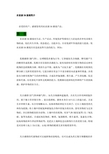
农富康EM菌液简介亲爱的用户,感谢您使用农富康EM菌液产品。
第一章农富康EM菌液对生活、生产活动、环境保护等都有巨大好处的多种有益微生物组成。
他们共生共荣,状态稳定,功能齐全,具有集团军作战的强大能量,使农富康EM菌液具有造就良性生态的能力。
例如:乳酸菌群(嫌气性)。
以嗜酸乳杆菌为主导。
它靠摄取光合细菌、酵母菌产生的糖类形成乳酸。
乳酸具有很强的杀菌能力,能有效抑制有害微生物的活动和有机物的急剧腐败分解。
维持生态平衡。
被称为“后抗生素”。
乳酸菌在有机物发酵分解上发挥着重要作用,它能分解在常态下不易分解的木质素和纤维素,并消除未分解有机物产生的种种弊端;合成各种氨基酸、维生素、产生消化酶、促进新陈代谢,还有溶化不溶性无机磷的能力。
乳酸菌还能抑制连作障碍产生的致病菌,维护作物茁壮生长。
光合菌群(好气性和嫌气性)。
如光合细菌和蓝藻类。
具有光合作用和固氮作用。
属于独立营养微生物,能自我增殖。
菌体本身含60%以上的蛋白质,且富含多种维生素,还含有辅酶Q10、抗病毒物质和促生长因子;它以土壤接受的光和热为能源,将土壤中的硫氢和碳氢化合物中的氢分离出来,变有害物质为无害物质,并以植物根部的分泌物、土壤中的有机物、有害气体(硫化氢等)及二氧化碳、氮等为基质,合成抗氧化物质、糖类、氨基酸类、维生素类、氮素化合物、抗病毒物质和生理活性物质等;是肥沃土壤和促进动植物生长的重要力量。
特别是对贫瘠土地上(如丘陵、山地)植物的根系发育有极重要作用。
光合菌群的代谢物质可以被植物直接吸收,还可以成为其它微生物繁殖的养分。
光合细菌如果增殖,其它的有益微生物也会增殖。
例如:VA菌根菌以光合菌分泌的氨基酸为食饵,它既能溶解不溶性磷,又能与固氮菌共生,使其固氮能力成倍提高。
酵母菌群(好气性)。
它利用植物根部产生的分泌物、光合菌合成的氨基酸、糖类及其它有机物质产生发酵力,合成促进根系生长及细胞分裂的活性化物质。
酵母菌在农富康EM菌液中对于促进其它有益微生物增殖所需要的基质(食物)提供重要的给养保障。
Biolog使用手册1
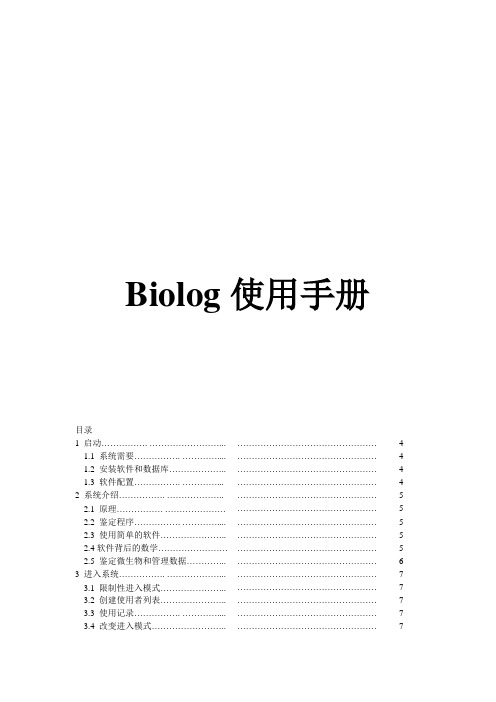
Biolog使用手册目录1 启动................ (4)1.1 系统需要................ . (4)1.2 安装软件和数据库 (4)1.3 软件配置................ (4)2 系统介绍................ .. (5)2.1 原理................ (5)2.2 鉴定程序................ . (5)2.3 使用简单的软件 (5)2.4软件背后的数学 (5)2.5 鉴定微生物和管理数据 (6)3 进入系统................ (7)3.1 限制性进入模式....................... (7)3.2 创建使用者列表 (7)3.3 使用记录................ . (7)3.4 改变进入模式 (7)4 准备样品................ (8)4.1 分离一个纯培养物 (8)4.2 革兰氏染色 (8)4.3 Wet Prep................ (8)4.4 定义好氧菌特征 (8)4.5 定义厌氧菌特征 (8)4.6 定义丝状真菌和酵母菌特征 (9)4.7 培养................ (9)4.8 准备接种物................ (9)4.9 革兰氏阳性产芽孢杆菌的处理 (9)4.10 丝状真菌的处理 (9)4.11 接种鉴定板................ (9)4.12 培养鉴定板................ .. (9)4.13 厌氧鉴定板的处理 (10)4.14 丝状真菌的准备 (10)4.15 GN,GP,AN的准备 (10)5 读结果................ (11)5.1 登录................ . (11)5.2 选择人工,读数仪或文件输入模式 (11)5.3 选择打印方法................ (11)5.4 人工读结果................ (11)5.5 用读数仪读结果 (11)5.6 从文件读结果 (11)5.7 设置一个工作表 (11)5.8 设置保存文件................ (11)5.9 使用工作表来读多个平板 (11)5.10 人工调整域值 (11)5.11 选择数据库................ (12)5.12 退出................ .. (12)6 结果解释................ (13)6.1 读结果................ . (13)6.2 评估鉴定结果的准确性 (13)6.3 解释不好的鉴定结果的可能原因.. (13)6.4 种的比较................ . (14)6.5 查找并评估种的信息 (14)6.6 使用真菌的宏观和微观图片 (15)6.7 查看更多的种................ (15)6.8 评估原始OD值 (15)7 数据管理和编辑数据库 (16)7.1 文件备份................ . (16)7.2 文件合并................ . (16)7.3 文件浏览和编辑 (16)7.4 自定义数据文件 (16)7.5 输入/输出ASCII数据 (17)7.6 输出为ACCESS (17)7.7 群落分析 (17)8 技术注解 (19)8.1 材料列表 (19)8.2 培养基和接种液准备 (19)8.3 特殊用途的微孔板 (22)9 经常问到的问题 (23)10 故障处理 (25)10.1 革兰氏染色 (25)10.2 培养微生物 (25)10.3准备接种物 (26)10.4接种微板 (26)10.5培养微板 (26)10.6 读数仪 (27)11 术语表 (28)12 附录 (30)附录1 微孔板的数据统计.附录2 样品准备的流程表附录3 真菌样品准备的流程表附录4 数据库表及特性附录5 结果打印输出的格式附录6 危险病原菌数据库附录7 产品注册表1 启动1.1 系统需要计算机(Windows95,98,2000或NT, 有光驱和软驱),显示器,鼠标,键盘,读数仪,浊度仪,菌落放大灯,八头电动加液器,系统软件。
BEVPOR MW 微生物过滤器说明说明书

BEVPOR MW filters provide full retention to industry regulated, water contaminating organisms to ensure the microbiological safety of bottled water .The inert and highly asymmetric PES membrane provides validated microbial retention to regulated, contaminating organisms. The 0.2µm grade provides complete sterility in accordance to ASTM F838-05 requirements. Combined with hydrophilic properties for easy integrity testing, BEVPOR MW filters provide assured performance throughout their service life. The incorporation of an integral prefilter layer allows graded retention throughout the depth of the filter to resist blockage, resulting in increased capacity and long service lifetimes. BEVPOR MW filters have been designed to provide a cost- effective solution to the microbial sterilization andstabilization of bottled water by providing increased process control with increased operational efficiency.FeaturesPerformance CharacteristicsBenefitsFiltration Stage❙ Validated retention to industry regulated organisms ❙ Inert materials of construction ❙ Easily integrity tested in-situ ❙ Integral depth prefiltration layer❙ Ensures the safety of the water prior to bottling❙ Protects the purity and essential characteristics of the source water ❙ Assured filtration performance ❙ Increased throughput to blockageBEVPOR MW Bottled WaterFilter CartridgesD i f f e r e n t i a l P r e s s u r e (m b a r )D i f f e r e n t i a l P r e s s u r e (p s i )Flow (L / min) for liquid @ 20 °C and 1 cp 10¨module100755025SpecificationsMaterials of Construction❙ Filtration Membrane: Polyethersulphone ❙ Prefilter Layer:Polyester ❙ Upstream Support: Polyester ❙ Downstream Support: Polyester❙ Inner Support Core: Polypropylene ❙ Outer Protection Cage: Polypropylene ❙ End Caps:Nylon❙ End Cap Insert: 316L Stainless Steel ❙ O-rings:Silicone / EPDMFood Contact ComplianceMaterials conform to the relevant requirements of FDA 21CFR Part177, current EC1935 / 2004 and current USP Plastics Class VI - 121 °C.Recommended Operating ConditionsUp to 70 °C (158 °F) continuous operating temperature and higher short-termtemperatures during CIP to the following limits:Effective Filtration Area (EFA)10¨ (250 mm)Up to 0.6 m 2(6.45 ft 2)Cleaning and SterilizationBEVPOR MW cartridges can be repeatedly steam sterilized in-situ or autoclaved at up to 130 °C (266 °F). They can be sanitized with hot water at up to 90 °C (194 °F) and are compatible with a wide range of chemicals. Please refer to our Clean-in-Place support guide or contact your local Parker representative for more information.Retention Characteristics0.2µm BEVPOR MW filters have been validated to provide sterile effluent after bacterial challenge testing following ASTM F838-05 methodology on 10” cartridges with more than 107cfu per cm 2 using Brevundimonas diminuta .In addition, challenges with the following EU regulated organisms have been performed.Integrity Test DataAll filters are flushed with pharmaceutical grade purified water prior to despatch. They are integrity tested to the following limits:Manufacturing TraceabilityEach filter cartridge displays the product name, product code and lot number .Additionally , each module displays a unique serial number providing full manufacturing traceability.Temperature Max Forward dP °C °F (bar) (psi) 20 68 5.0 72.5 40 104 4.0 58.0 60 140 3.0 43.5 80 176 2.0 29.0 901941.0 14.5>100 (steam)>212 (steam)0.3 4.0DS_BW_07_01/14 Rev. 1BParker domnick hunter has a continuous policy of product development and although the Company reserves the right to change specifications, it attempts to keep customers informed of any alterations. This publication is for general information only and customers are requested to contact our Process Filtration Sales Department for detailed information and advice on a products suitability for specific applications. All products are sold subject to the company’s standard conditions of sale.Organism LRV when challenged with a minimum of 107 cfu per cm 20.200.45Serratia marcescensFR FR Escherichia coli FR FR Enterococcus faecalis FR FR Clostridium perfringensFR FR Pseudomonas aeruginosa FR FR Brevundimonas diminutaFR 5*FR - Fully retentive during challengeWhen expressed as titre reduction “FR” equates to >107per 10¨module.E u r o p e : ✆ +44 (0)191 4105121 d h p r o c e s s @p a r k e r .c o m | N o r t h A m e r i c a : ✆ t o l l f r e e : +1 877 784 2234 d h p s a l e s .n a @p a r k e r .c o m | w w w .p a r k e r .c o m /d h b o t t l e d w a t e rOrdering informationBEVPOR MWBottled WaterDiffusional Flow Micron Rating Test Parameters 0.20 0.45 Test Pressure (barg) 2.4 1.7 Test Pressure (psig) 35.0 25.0Max DiffusionalFlow per 10¨ (ml /min)16.016.0BMW A--Code | Length (Nominal)Code | Micron Code | End Cap (10 inch)Code | O-rings VSH & HSLHOUSING RANGE AVAILABLE。
微生态饲料添加剂
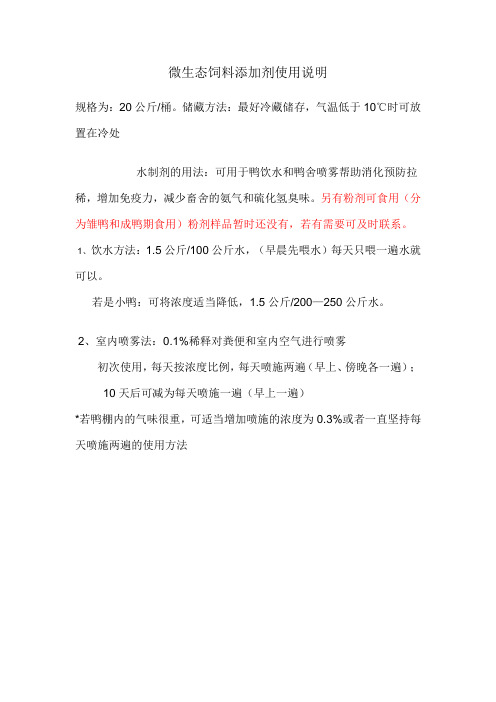
微生态饲料添加剂使用说明
规格为:20公斤/桶。
储藏方法:最好冷藏储存,气温低于10℃时可放置在冷处
水制剂的用法:可用于鸭饮水和鸭舍喷雾帮助消化预防拉稀,增加免疫力,减少畜舍的氨气和硫化氢臭味。
另有粉剂可食用(分为雏鸭和成鸭期食用)粉剂样品暂时还没有,若有需要可及时联系。
1、饮水方法:1.5公斤/100公斤水,(早晨先喂水)每天只喂一遍水就可以。
若是小鸭:可将浓度适当降低,1.5公斤/200—250公斤水。
2、室内喷雾法:0.1%稀释对粪便和室内空气进行喷雾
初次使用,每天按浓度比例,每天喷施两遍(早上、傍晚各一遍);
10天后可减为每天喷施一遍(早上一遍)
*若鸭棚内的气味很重,可适当增加喷施的浓度为0.3%或者一直坚持每天喷施两遍的使用方法。
益生菌使用手册
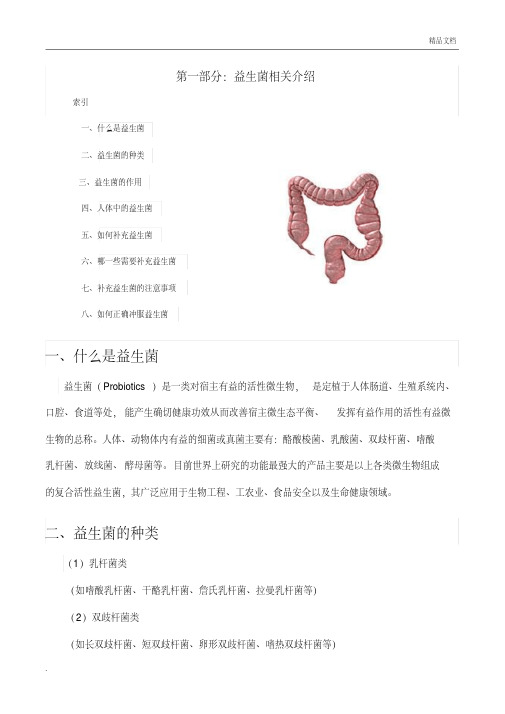
第一部分:益生菌相关介绍索引一、什么是益生菌二、益生菌的种类三、益生菌的作用四、人体中的益生菌五、如何补充益生菌六、哪一些需要补充益生菌七、补充益生菌的注意事项八、如何正确冲服益生菌一、什么是益生菌益生菌(Probiotics)是一类对宿主有益的活性微生物,是定植于人体肠道、生殖系统内、口腔、食道等处,能产生确切健康功效从而改善宿主微生态平衡、发挥有益作用的活性有益微生物的总称。
人体、动物体内有益的细菌或真菌主要有:酪酸梭菌、乳酸菌、双歧杆菌、嗜酸乳杆菌、放线菌、酵母菌等。
目前世界上研究的功能最强大的产品主要是以上各类微生物组成的复合活性益生菌,其广泛应用于生物工程、工农业、食品安全以及生命健康领域。
二、益生菌的种类(1)乳杆菌类(如嗜酸乳杆菌、干酪乳杆菌、詹氏乳杆菌、拉曼乳杆菌等)(2)双歧杆菌类(如长双歧杆菌、短双歧杆菌、卵形双歧杆菌、嗜热双歧杆菌等)(3)革兰氏阳性球菌(如粪链球菌、乳球菌、中介链球菌等)。
三、益生菌的作用益生菌是一类对宿主有益的活性微生物,人体、动物体内有益的细菌或真菌主要有:酪酸梭菌、乳酸菌、双歧杆菌、嗜酸乳杆菌、放线菌、酵母菌等。
益生菌是定植于人体肠道、生殖系统内,能产生确切健康功效从而改善宿主微生态平衡、发挥有益作用的活性有益微生物的总称。
1、益生菌有缓解乳糖不耐症状,促进机体营养吸收的作用:益生菌有助于营养物质在肠道内的消化。
它能分解乳糖成为乳酸,减轻乳糖不耐症。
双歧杆菌和乳酸杆菌不仅可以产生各种维生素如维生素B1、B2、B6、B12、烟酸和叶酸等以供机体所需,还能通过抑制某些维生素分解菌来保障维生素的供应。
另外,双岐杆菌还可以降低血氨改善肝脏功能。
2、益生菌有整肠作用,调整微生态失调,防治腹泻:益生菌活着进入人体肠道内,通过其生长及各种代谢作用促进肠内细菌群的正常化,抑制肠内腐败物质产生,保持肠道机能的正常。
对病毒和细菌性急性肠炎及痢疾,便秘等都有治疗及预防作用。
微生态产品的使用和注意事项

微生态产品的使用和注意事项一、使用剂量微生态制剂的益生作用是通过有益微生物在动物体内一系列生理活动来实现的,其最终效果同施加的益生菌的数量密切相关,数量不够,在体内不能形成菌群优势,难以起到益生作用。
根据试验,如果一种细菌在盲肠内容物的浓度低于107个/g,该菌产生的酶及代谢产物不足以影响宿主;数量过多,超出占据肠内附着点和形成优势菌群所需的菌量,非但功效不会增加,反而造成不必要的浪费。
微生态制剂用于特定养殖动物所需的菌群数量尚无统一的规定,德国学者认为,仔猪饲料中加入微生态制剂其含菌量应达到(0.2~0. 5)×107个/g饲料,育肥猪饲料中加入每克含106个芽胞杆菌,粪中大肠杆菌减少35%,每天0.5~0.6g方可起到治疗效果,而乳酸杆菌因制剂不同而有差异,其数量不少于107个/g,每日施加0.1~3g,一般添加量为0.02%~0.2%。
二、使用时间微生态制剂在动物的整个生长过程都可以使用,但不同的生长时期其作用效果不尽相同。
一般在动物幼体,此时体内微生态平衡尚未完全建立,抵抗疾病的能力较弱,此时引入益生菌,可较快地进入体内,占据附着点,效果最佳。
如新生反刍动物肠道内有益微生物种群数量的增加不仅可以促进宿主动物对纤维素的消化,而且有助于防止病原微生物侵害肠道。
和其他刚出生的哺乳动物一样,新生反刍动物的胃肠道尚未完全发育,但细菌在肠道内的定植相当迅速,出生24h出现乳酸杆菌和链球菌,l周龄时,整个肠道内乳酸杆菌数量达107~109个/g。
另外在断奶、运输、饲料转变、天气突变和饲养环境恶劣等应激条件下,动物体内微生态平衡遭到破坏,使用微生态制剂对形成优势种群极为有利,因此,把握益生菌的应用时机,尽早并长期饲喂,使其益生作用得到充分体现三、影响微生态效果的因素微生态制剂具有调整微生态失调、生物拮抗、代谢产物(如乳酸、醋酸、丙酸、过氧化氢和细菌素等活性物质)作用、增强免疫、促进机体营养消化吸收、解毒排毒、防病治病等作用。
BacLight RedoxSensor CTC Vitality Kit产品说明书
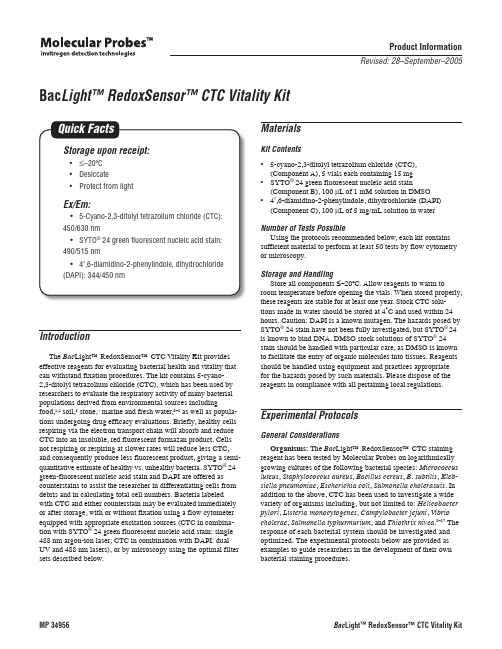
Product InformationStorage upon receipt:• ≤–20ºC • Desiccate• Protect from lightEx/Em:• 5-Cyano-2,3-ditolyl tetrazolium chloride (CTC):450/630 nm• SYTO ® 24 green fluorescent nucleic acid stain:490/515 nm• 4′,6-diamidino-2-phenylindole, dihydrochloride (DAPI): 344/450 nmQuick FactsRevised: 28–September–2005IntroductionThe Bac Light™ RedoxSensor™ CTC Vitality Kit provides effective reagents for evaluating bacterial health and vitality that can withstand fixation procedures. The kit contains 5-cyano-2,3-ditolyl tetrazolium chloride (CTC), which has been used by researchers to evaluate the respiratory activity of many bacterial populations derived from environmental sources includingfood,1,2 soil,3 stone,4 marine and fresh water,5–8 as well as popula-tions undergoing drug efficacy evaluations. Briefly, healthy cells respiring via the electron transport chain will absorb and reduce CTC into an insoluble, red fluorescent formazan product. Cells not respiring or respiring at slower rates will reduce less CTC, and consequently produce less fluorescent product, giving a semi-quantitative estimate of healthy vs. unhealthy bacteria. SYTO ® 24 green-fluorescent nucleic acid stain and DAPI are offered as counterstains to assist the researcher in differentiating cells from debris and in calculating total cell numbers. Bacteria labeled with CTC and either counterstain may be evaluated immediately or after storage, with or without fixation using a flow cytometer equipped with appropriate excitation sources (CTC in combina-tion with SYTO ® 24 green fluorescent nucleic acid stain: single 488 nm argon-ion laser; CTC in combination with DAPI: dual UV and 488 nm lasers), or by microscopy using the optimal filter sets described below.MaterialsKit Contents• 5-cyano-2,3-ditolyl tetrazolium chloride (CTC), (Component A), 5 vials each containing 15 mg • SYTO ® 24 green fluorescent nucleic acid stain(Component B), 100 μL of 1 mM solution in DMSO • 4′,6-diamidino-2-phenylindole, dihydrochloride (DAPI) (Component C), 100 μL of 5 mg/mL solution in waterNumber of Tests PossibleUsing the protocols recommended below, each kit contains sufficient material to perform at least 50 tests by flow cytometry or microscopy.Storage and HandlingStore all components ≤–20ºC. Allow reagents to warm toroom temperature before opening the vials. When stored properly, these reagents are stable for at least one year. Stock CTC solu-tions made in water should be stored at 4˚C and used within 24 hours. Caution: DAPI is a known mutagen. The hazards posed by SYTO ® 24 stain have not been fully investigated, but SYTO ® 24 is known to bind DNA. DMSO stock solutions of SYTO ® 24 stain should be handled with particular care, as DMSO is known to facilitate the entry of organic molecules into tissues. Reagents should be handled using equipment and practices appropriate for the hazards posed by such materials. Please dispose of the reagents in compliance with all pertaining local regulations.Experimental ProtocolsGeneral ConsiderationsOrganisms: The Bac Light™ RedoxSensor™ CTC staining reagent has been tested by Molecular Probes on logarithmically growing cultures of the following bacterial species: Micrococcus luteus , Staphylococcus aureus , Bacillus cereus , B. subtilis , Kleb-siella pneumoniae , Escherichia coli , Salmonella cholerasuis . In addition to the above, CTC has been used to investigate a wide variety of organisms including, but not limited to: Helicobacter pylori , Listeria monocytogenes , Campylobacter jejuni , Vibrio cholerae , Salmonella typhurmurium , and Thiothrix nivea .8–17 The response of each bacterial system should be investigated and optimized. The experimental protocols below are provided as examples to guide researchers in the development of their own bacterial staining procedures.Bac Light™ RedoxSensor™ CTC Vitality KitStaining environment: The removal of an organism from its growth medium and placement in a different environment may enhance or inhibit the organismʼs reductase activity and overall response to CTC. Therefore, choices of staining buffer and condi-tions need to be considered carefully in the context of the desired end results, assays, instrumentation, and analyses.Staining concentrations and incubation times: Protocols described in published scientific literature recommend staining with concentrations of CTC ranging from 2–6 mM, with 5 mM being the more common concentration. Incubation times range from 5 minutes to 24 hours. The optimal incubation condition may depend upon the organism being investigated and the experi-mental system.Counterstaining: SYTO® 24 green-fluorescent nucleic acid stain and DAPI are offered as counterstains to assist the researcher in differentiating cells from debris and in calculating total cell numbers. The staining concentrations and conditions will vary with live/dead status and analysis platform (flow cytometry or microscopy). SYTO® 24 green fluorescent nucleic acid stain may be used on live or fixed samples at a concentration of 10 nM for flow cytometry or 1 μM for microscopy; DAPI may be used at 10 μg/mL for flow cytometry (UV-laser required) on live or fixed samples, but the dimly stained live population may not be detect-able using a microscope.Calculating percent active and determining total numbers: A number of factors can impact the determination of vitality and total cell numbers with the Bac Light™ RedoxSensor™ CTC Vitality Kit, including metabolic status, membrane integrity, and gram character. In most cases, the counterstains will stain all bacteria and the CTC will stain those with active dehydrogenases. However in some cases, fluorescence resonance energy transfer may interfere with counterstain fluorescence in CTC-positive cells. In these situations, the total population would be the sum of cells positive for either CTC or the counterstain. The active cell index can be calculated as the percentage of total cells that are CTC-positive.Preparation of Working Solutions1.1 CTC. Each vial of CTC (Component A) contains 15 mg. Dissolve the contents of one vial with 1 mL ultrapure waterfor a final concentration of 50 mM. Most protocols recommend staining with a 5 mM staining solution (final concentration).1.2 Sterile buffers. Phosphate-buffered saline (PBS) or PBS + 10 mM glucose (PBSG) have been shown to be adequate staining buffers for both gram-positive and gram-negative bacteria. Addi-tives that reduce respiration activity (e.g., sodium azide) may also inhibit CTC reduction. Sterilize staining buffers using 0.2 μm filtration.1.3 SYTO® 24 green fluorescent nucleic acid stain. For flow cytometry use, prepare a 10 μM working solution with a 1:100 dilution of the 1 mM stock solution of SYTO® 24 green fluores-cent nucleic acid stain using a high-quality, anhydrous DMSO. Adding 1 μL of the working solution to 1 mL cell samples will give a final staining solution of 10 nM.Staining the Bacteria2.1 Grow cultures according to necessary growth conditions. Cells in log-phase and showing optimal vitality will reduce the highest level of CTC, resulting in a greater percentage of the population producing high fluorescence signal.2.2 Dilute cells either washed in warm buffer (PBS or PBSGare suitable) or directly from the culture into warm buffer to~106 cells/mL. Aliquot ~1 mL to flow cytometry tubes. If desired, prepare an inactivated control by treating with 10% alcohol or1–4% formaldahyde.2.3 Add 100 μL of the 50 mM Bac Light™ RedoxSensor™ CTC working solution (prepared in step 1.1). Vortex gently to mix. Incubate 30 minutes at 37o C, protected from light. Note: Reserve a sample without dye addition as an unstained bacteria control.2.4 Analyze by flow cytometry without washing. If desired, CTC-stained cells may be counterstained (protocol below). Form-aldehyde treatment (1–4% final concentration) can be employed to fix CTC-stained cells, and this step can be carried out before counterstaining.Counterstaining (Optional)Cells may be counterstained with SYTO® 24 nucleic acid stain or DAPI at either room temperature or 37˚C for 15 minutes at recommended final concentration (see Table 1) and then analyzed immediately. Cells may also be fixed with 1–4% formaldehyde and prior to counterstaining. Samples may be analyzed without washing.3.1 For counterstaining with SYTO® 24 green fluorescent nucleic acid stain:Flow cytometry: Transfer 1 μL of the 1:100 dilution ofSYTO® 24 nucleic acid stain working solution (prepared in step 1.3) to 1 mL of CTC-labeled cells.Microscopy: Transfer 1 μL of the undiluted stock solution of SYTO® 24 nucleic acid stain (1 mM) to 1 mL of CTC-la-beled cells.3.2 For counterstaining with DAPI:Flow cytometry and microscopy: Transfer 2 μL of the5 mg/mL stock solution of DAPI to 1 mL of CTC-labeled cells. Table 1. Concentrations of SYTO®24 nucleic acid stain and DAPI for counterstaining.Adjusting the Flow Cytometer and Analyzing the SamplesInstrument capabilities may vary considerably, but the tech-niques and parameters established here should aid in setting up analyses in the majority of flow cytometers now in use. In the flow cytometer, bacteria are identified solely on the basis of their size and staining. It is best to inspect each sample by fluorescence microscopy to confirm that the particles detected are indeed bac-teria (see Analyzing the Stained Bacteria in Suspension by Fluo-rescence Microscopy ). Unstained and single-color controls should be used to locate cell populations and determine compensation settings.4.1 Instrument configuration. Use appropriate excitation sources and emission filters for stained bacteria samples (see Quick Facts ). If bacteria are costained with SYTO ® 24 nucleic acid stain and CTC, a single 488 nm excitation source is appropriate. If bacteria are stained with DAPI and CTC, a dual excitation (UV and 488 nm) instrument configuration is required.4.2 Instrument set-up4.2.1 Set amplifiers to logarithmic amplification. Use side-scatter and/or forward scatter to set threshold parameter. 4.2.2 With an unstained sample of bacteria cells, set the amplification of the signals from forward and side scatter so that the bacteria are in the middle of the data space. Adjust threshold to minimize electronic noise appearing on the monitor. To avoid coincidence error, maintain flow rate ≤1000 events/second. Set a gate on the bacterial population (Figure 1).4.2.3 On the red fluorescence histogram used for CTC analysis, set the fluorescence amplification so that the unstained bacteria are in the lowest decade of the plot. Refer to the position of the formaldehyde-tested control in Figure 2.4.2.4 Using the active bacteria control stained only with the RedoxSensor™ CTC reagent, verify that the signal appears above the level of the unstained or inactivated control in the red fluores-cence channel (Figure 2).4.2.5 When using a nucleic acid counterstain, use a single color control to set the voltage of the PMT so that the bacterial signal appears above background (Figure 3). To exclude acel-lular fluorescence, set a gate on the population stained with the nucleic acid counterstain.Note: The cytometer may also be configured to trigger on fluo-rescence, capturing events that are labeled with a nucleic acid stain, thereby reducing the level of background noise.4.3 After adjusting the flow cytometer as described above, apply a control or experimental sample containing stained bacteria, gated as in Figures 1 and 3. Analyze in green versus red fluorescence, marking populations as in Figure 4. If necessary, adjust the com-pensation settings with single color controls.Figure 1. Dot plot of forward scatter vs. side scatter obtained on a sample of unstained bacteria analyzed using a BD FACSCalibur™ flow cytometer with thresholds set on forward and side scatter. The region R1 contains particles of the appropriate size forbacterial cells and is used to set the instrument to exclude debris in the sample.Figure 3. Dot plot of green fluorescence vs. side scatter. The region R2 contains events stained with SYTO ®24 nucleic acid stain.Figure 2. Untreated or formaldehyde-treated E. coli were stained with 5 mM CTC (30 minutes at 37ºC) and analyzed on a flow cytometer using 488 nm excitation anda 670 nm longpass filterAnalyzing the Stained Bacteria in Suspension by Fluores-cence MicroscopyBacteria stained using Bac Light™ RedoxSensor™ CTCVitality Kit may be viewed using most standard epifluorescencemicroscopes with the appropriate filters. For the dyes CTC,SYTO® 24 nucleic acid stain, and DAPI, standard Texas Red®dye, FITC (Alexa Fluor® 488 dye), and DAPI filters, respec-tively, are appropriate. Filter sets are available for simultaneousviewing of dual-stained populations, as well. More informationon appropriate filter sets can be found at ,, and .To analyze any of the samples in suspension using fluores-cence microscopy, trap 5 μL of the stained bacteria suspensionbetween a slide and an 18 mm square coverslip and observe on afluorescence microscope equipped with the appropriate filters. Figure 4. E. coli were stained with 5 mM CTC and 10 nM SYTO® 24 nucleic acid stain,then analyzed on a flow cytometer with 488 nm excitation and with 530 bandpass and670 longpass filters. Events are not gated as in Figures 1 and 3 to demonstrate the pres-ence of debris in the sample.References1. Cytometry 54A, 27 (2003);2. Appl Environ Microbiol 69, 2857 (2003);3. Biodegradation 13, 285 (2002);4. J Microbiol Methods 52, 75 (2003);5. Int J Food Microbiol 92, 327 (2004);6. J Microbiol Methods 52, 47 (2003);7. Huan Jing Ke Zue (article in Chinese) 25, 167 (2004);8. Appl Environ Microbiol 69, 7462 (2003);9. APMIS 106, 571 (1998); 10. Vet Res 33, 359 (2002); 11. J Appl Bacteriol 77, 353 (1994); 12. Appl Environ Microbiol69, 711 (2003); 13. Int J Food Microbiol 89, 31 (2003); 14. Syst Appl Microbiol 24, 331 (2001); 15. Cytometry 29, 298 (1997); 16. FEMS MicrobiolLett 179, 265 (1999); 17. Appl Environ Microbiol 69, 641 (2003).Prod u ct List Current pric e s may be ob t ained from our Web site or from our Customer Service Department.Cat # Product Name Unit SizekitB34956 Bac Light™ RedoxSensor™ CTC Vitality Kit *for flow cytometry and microscopy* (1)Contact InformationFurther information on Molecular Probes products, including product bibliographies, is available from your local distributor or directly from Molecular Probes. Customers in Europe, Africa and the Middle East should contact our office in Paisley, United Kingdom. All others should contact our Technical Service Department in Eugene, Oregon. Please visit our website — — for the most up-to-date information.Molecular Probes, Inc.29851 Willow Creek Road, Eugene, OR 97402Phone: (541) 465-8300 • Fax: (541) 335-0504Customer Service: 6:00 am to 4:30 pm (Pacific Time)Phone:(541)335-0338•Fax:(541)335-0305•************************** Toll-Free Ordering for USA:Order Phone: (800) 438-2209 • Order Fax: (800) 438-0228Technical Service: 8:00 am to 4:00 pm (Pacific Time)Phone: (541) 335-0353 • Toll-Free (800) 438-2209Fax: (541)335-0238•*************************Invitrogen European HeadquartersInvitrogen, Ltd.3 Fountain DriveInchinnan Business ParkPaisley PA4 9RF, UKPhone: +44 (0) 141 814 6100 • Fax: +44 (0) 141 814 6260 Email:*********************** TechnicalServices:***********************Molecular Probes products are high-quality reagents and materials intended for research pur p os e s only. These products must be used by, or directl y under the super v ision of, a tech n ically qual i f ied individual experienced in handling potentially hazardous chemicals. Please read the Material Safety Data Sheet pro v id e d for each prod u ct; other regulatory considerations may apply.Limited Use Label LicenseFor research use only. Not intended for any animal or human therapeutic or diagnostic use. The purchase of this product conveys to the buyer the non-transferable right to use the purchased amount of the product and components of the product in research conducted by the buyer (whether the buyer is an academic or for-profi t entity). The buyer cannot sell or otherwise transfer (a) this product (b) its components or (c) materials made using this product or its components to a third party or otherwise use this product or its components or materials made using this product or its components for Commercial Purposes. The buyer may transfer information or materials made through the use of this product to a scientifi c collaborator, provided that such transfer is not for any Commercial Purpose, and that such collaborator agrees in writing (a) to not transfer such materials to any third party, and (b) to use such transferred materials and/or information solely for research and not for Com-mercial Purposes. Commercial Purposes means any activity by a party for consideration and may include, but is not limited to: (1) use of the product or its components in manufacturing; (2) use of the product or its components to provide a service, information, or data; (3) use of the product or its components for therapeutic, diagnos-tic or prophylactic purposes; or (4) resale of the product or its components, whether or not such product or its components are resold for use in research. Invitrogen Corporation will not assert a claim against the buyer of infringement of the above patents based upon the manufacture, use or sale of a therapeutic, clinical diagnostic, vaccine or prophylactic product developed in research by the buyer in which this product or its components was employed, provided that neither this product nor any of its components was used in the manufacture of such product. If the purchaser is not willing to accept the limitations of this limited use statement, Invitrogen is willing to accept return of the product with a full refund. For information on purchasing a license to this product for purposes other than research, contact Molecular Probes, Inc., Business Development, 29851 Willow Creek Road, Eugene, OR 97402. Tel: (541) 465-8300. Fax: (541) 335-0504.Several Molecular Probes products and product applications are covered by U.S. and foreign patents and patents pending. All names con t ain i ng the des i g n a t ion ® are reg i s t ered with the U.S. Patent and Trade m ark Offi ce.Copyright 2005, Molecular Probes, Inc. All rights reserved. This information is subject to change without notice.。
生态环境科技股份有限公司产品手册p
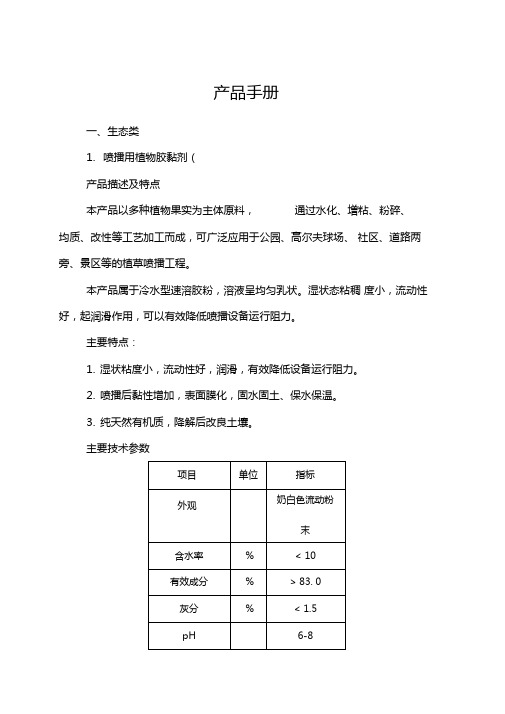
产品手册一、生态类1.喷播用植物胶黏剂(产品描述及特点本产品以多种植物果实为主体原料,通过水化、増粘、粉碎、均质、改性等工艺加工而成,可广泛应用于公园、高尔夫球场、社区、道路两旁、景区等的植草喷播工程。
本产品属于冷水型速溶胶粉,溶液呈均匀乳状。
湿状态粘稠度小,流动性好,起润滑作用,可以有效降低喷播设备运行阻力。
主要特点:1.湿状粘度小,流动性好,润滑,有效降低设备运行阻力。
2.喷播后黏性增加,表面膜化,固水固土、保水保温。
3.纯天然有机质,降解后改良土壤。
主要技术参数3.产品描述及特点多功能节水树盘是一种新型、高效水保工程用器具。
以PE 为原料按一定结构、辅之塑料或金属管件制成的一种贮水容器,可用于树木、作物根兜部,起蓄水挡水、滴灌、施肥(液体肥料)等作用,替代开筑式树盘,大大减少土地扰动。
主要特点:1.减少浇灌用水,提高作物成活率。
2.适用于干旱少雨地区经济作物的栽植。
主要技术参数4.喷播木纤维产品描述及特点本产品以木材加工剩余物为原料,采用高温、、高压机械分解方式生产而成。
可广泛应用于公路鴻路、矿山恢复等各类喷播鄴]y 7上i 疝复n i j •二黑&: 工程的辅料。
主要特点:1.有机物含量达到95-99%,无菌虫病害,能够促进土壤熟化。
2.与其他纤维相比,吸水、保水性更强,释水更缓慢、均匀、持久。
3.土壤保墒,调整表层土壤结构,涵养水分,防止流失。
主要技术参数5.产品描述及特点按照叶落归根、秸秆还田、改良土壤的理念,将农、林产业中剩余生物质资源转化为生态修复的工业化产品。
可应用于沙质土、山坡及河流两岸、铁路、公路两侧,果园、公园、以及飞机场、足球场、高尔夫球场、屋顶花园等。
是国际公认的最有效、最简便、最廉价的护土、治沙、绿化环保产品之一。
主要特点:1.可降解、无污染。
2.保水保墒、抗侵蚀,改善土壤结构。
3.呵护种子萌芽、出苗、展叶。
4.抗逆物种快速回归,植被多元化快速恢复。
主要技术参数6.微集雨滴灌系统(专利号:)产品描述及特点本系统是我公司研制开发的一种新型、高效水保工程用器具铺设于树木、作物根兜部,起收集贮存雨水、滴灌作物的作用,同时具有保墒、增强光辐射,促进作物生长等功能;可有效利用自然降雨,大幅减少浇灌用水,提高作物成活率。
- 1、下载文档前请自行甄别文档内容的完整性,平台不提供额外的编辑、内容补充、找答案等附加服务。
- 2、"仅部分预览"的文档,不可在线预览部分如存在完整性等问题,可反馈申请退款(可完整预览的文档不适用该条件!)。
- 3、如文档侵犯您的权益,请联系客服反馈,我们会尽快为您处理(人工客服工作时间:9:00-18:30)。
理想的可直接饲用的微生物菌种应该是:①不会使人和动物致病,不与病原微生 物产生杂交种;②在体内外易于繁殖,体外繁殖速度快;③在低 pH 和胆汁中可以存 活,并能植入肠粘膜;④在发酵过程中能产生乳酸和过氧化氢等物质;⑤能合成对大 肠杆菌、沙门氏菌、葡萄球菌、梭状芽孢杆菌等肠道致病菌的抑制物而不影响自己的 活性;⑥经加工后活菌存活率高,混入饲料后高温下稳定性好;⑦最好来自动物自身 肠道中;⑧有利于促进宿主的生长发育及提高抗病能力。
康地恩生物集团
CONTINENT BIOTECH GROUP
微生态产品使用手册
康地恩生物技术部 2008 年 6 月
康地恩生物
使命 为了生命更自然、更健康。
发展愿景 创建一流生物发酵企业。 高度开放和多元合作的现代高科技企业,充分满足个人成功需要的集团化平台。
康地恩生物下属分公司 山东六和农牧科技园有限公司 山东康地恩生物科技有限公司 山东潍坊康地恩生物科技有限公司 上海三智生物科技有限公司 石家庄康地恩生物科技有限公司 济宁康地恩肥业有限公司 烟台康地恩肥业有限公司 东营凯地恩肥业有限公司
附录:微生态产品活菌量检测方法 ....................................................................................................... 29 一、芽孢杆菌活菌含量检测 ........................................................................................................... 29 二、乳酸菌活菌含量测定 ............................................................................................................... 30 三、酵母菌活菌含量测定 ............................................................................................................... 31
第二部分 康地恩微生态产品...................................................................................................................6 一、康地恩微生态产品简介 ............................................................................................................. 6 二、康地恩微生态产品主要有效成分构成: .................................................................................6 三、康地恩微生态耐高温制粒性能和药物配伍试验 .....................................................................7 (一)康地恩微生态耐高温制粒能力 ..................................................................................... 7 (二)康地恩微生态与抗生素等药物的共用 .........................................................................8 四、康地恩微生态应用绩效表现 ................................................................................................... 10 (一)肉鸡应用康地恩微生态绩效表现 ...............................................................................10 (二)蛋鸡应用微生态绩效表现 ........................................................................................... 10 (三)养猪应用康地恩微生态绩效表现 ...............................................................................10 (四)奶牛业应用康地恩微生态绩效表现 ........................................................................... 11 (五)特种动物(皮毛动物)养殖应用康地恩微生态绩效表现 ....................................... 11 (六)水产养殖应用康地恩微生态绩效表现 ....................................................................... 11 五、一条龙企业和饲料厂专用超浓缩型微生态 ...........................................................................13
2.营养助消化作用:有益菌中的芽孢杆菌可产生蛋白酶、淀粉酶等消化酶,和胃 肠道固有的酶一起共同促进饲料的消化吸收,提高其利用率;有益菌可合成维生素 B 族、维生素 K、类胡萝卜素、氨基酸、生物活性物质辅酶 Q 及某些未知因子而参与物 质代谢,促进动物生长。乳酸菌产生乳酸,降低肠道 pH 值,促进维生素 D、钙、磷、 铁等矿物质微量元素的吸收。这不仅起到了很好的营养作用,而且对预防矿物质、维 生素、蛋白质代谢障碍等营养代谢病的发生,提高畜产品的产量和品质也极为重要。
第三部分 康地恩微生态应用研究报告...............................................................................................15 (一)日粮中添加微生态制剂对肉鸡生产性能的响 ...................................................................15 (二)康地恩液体微生态制剂治疗仔猪顽固性腹泻的影响 ...............................................19 (三)微生态制剂替代金霉素对肉鸡生产性能的影响 .......................................................21 (四)康地恩液体微生态对蛋种鸡生产性能的影响 ...........................................................24 (五)微生态制剂对热应激条件下肉鸡生产性能的影响 ...................................................26
1999 年农业部(第 105 号公告)公布了允许使用的的饲料级微生物添加剂菌种 12 个:干酪乳杆菌;植物乳杆菌;粪链球菌;屎链球菌;乳酸片球菌;枯草芽孢杆菌; 纳豆芽孢杆菌;嗜酸乳杆菌;乳链球菌;啤酒酵母菌;产朊假丝酵母;沼泽红假单胞 菌。不在上述允许范围的菌种用于微生态制剂生产时需由国家指定部门做严格的安全 性评价。
2
目录
第一部分 微生态基础.............................................................................................................................1 一、微生态制剂概念......................................................................................................................... 1 二、微生态制剂菌种选用及国家允许使用的菌种 .........................................................................1 三、微生态制剂的作用 ..................................................................................................................... 1 四、微生态制剂的种类 ..................................................................................................................... 3 五、微生态制剂在养殖业生产应用中所关注的几个问题 .............................................................3 六、微生态制剂与疫苗的区别 ......................................................................................................... 5
三、微生态制剂的作用
1.促进胃肠内微生态环境的恢复:常情况下,动物胃肠道内有大量有益菌群,
1
且彼此之间相互依存、相互制约、优势互补、既起着消化、营养的生理作用,也能抑 制病原菌等有害菌的侵入和繁殖,从而整体发挥预防感染的保健作用。当动物受到饲 料更换、断奶、运输、疾病及抗菌药物长期大量使用等应激作用时,会破坏消化道内 这些有益菌群平衡而成为病态。微生态制剂随饲料、饮水进入消化道后,在其内定居、 繁殖,建立起有益的优势菌群,从而使被破坏的微生态环境得以恢复。
